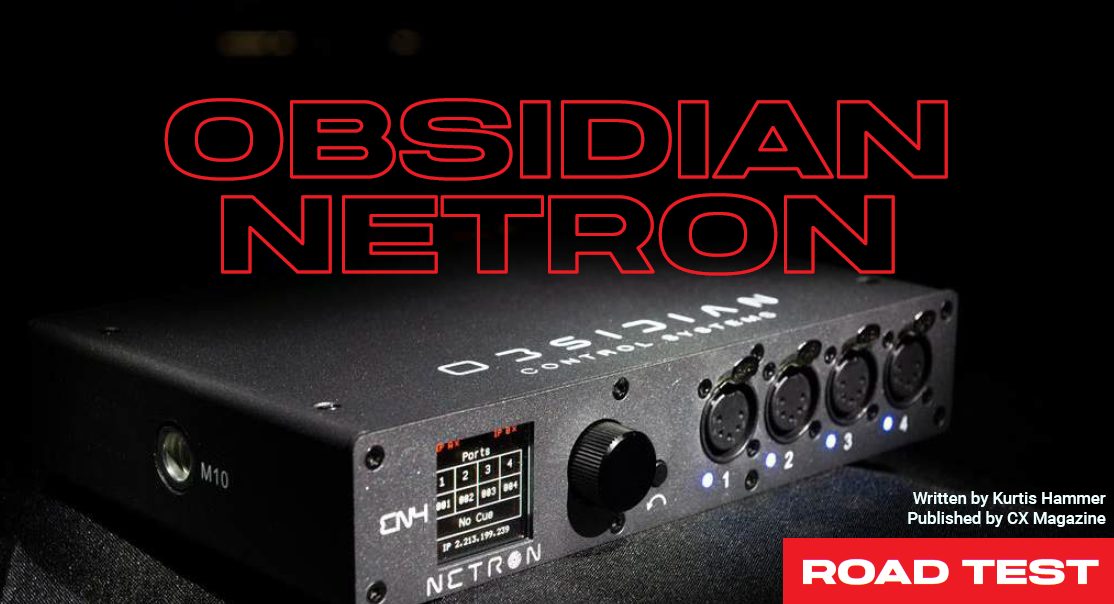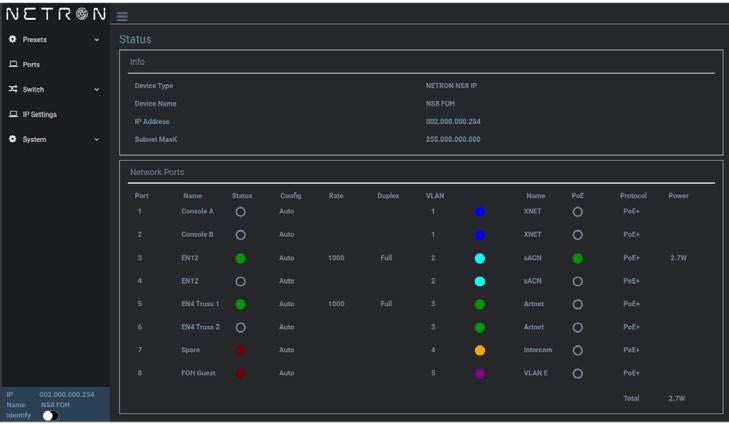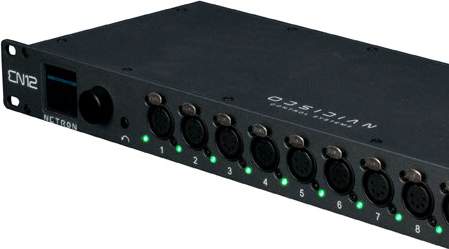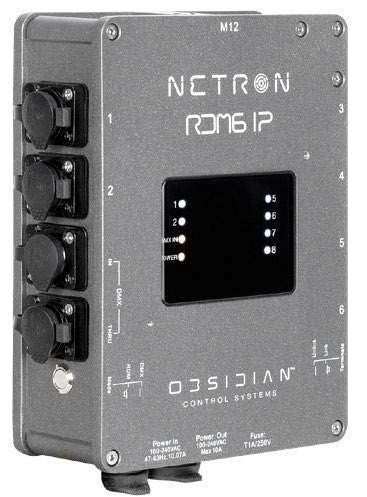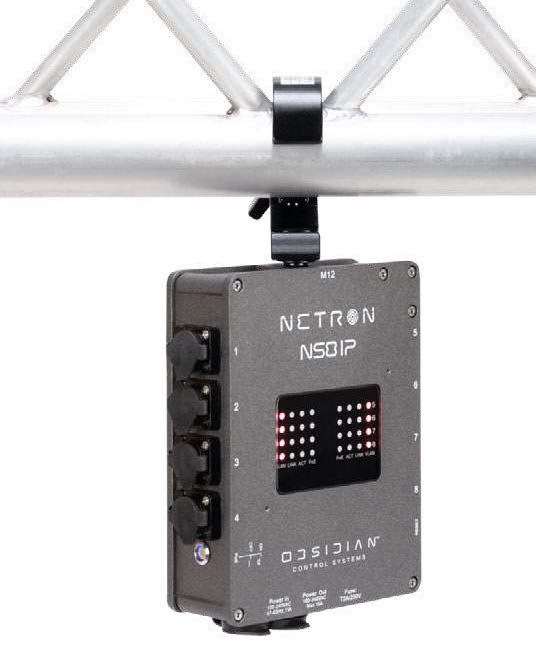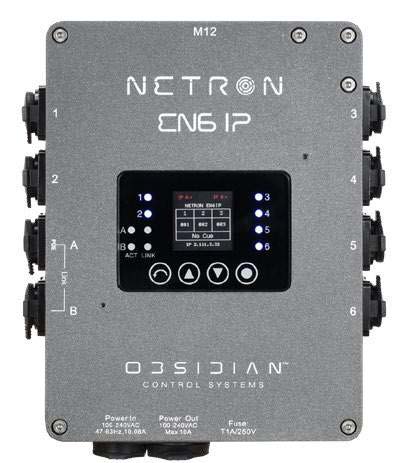Obsidian Netron Road Test
The Netron family of DMX Ethernet lighting control distribution solutions are made by Obsidian, which is owned by Elation. The range features nodes, controllers, splitters, switchers, and more, to provide robust backbone infrastructure for modern venues and touring shows. It has been tailored to suit both touring entertainment as well as architectural and installation.
The Netron family of data distribution solutions are made by Obsidian Control Systems, which is owned by Elation. The range features nodes, splitters, switches, and more to provide robust backbone infrastructure for modern venues and touring shows. It has been tailored to suit both touring entertainment as well as architectural and installation.
The Netron range is built to be set-up and used with any lighting console, supporting protocols such as DMX, RDM, sACN, and Art-Net.
Obsidian have built a reputation for making sure that their offerings remain relevant for a long time and focus on longevity, reassuring for those looking to make an investment in a lighting control distribution system.
The hardware range is vast and caters to just about every corner of the data distribution market. We have been able to sample a small selection of what they have on offer in the entertainment range in the EN4, RDM10, DMX10, EN12, NS8IP, and the EN6IP.
EN4
The EN4 is a 4-port/4-Universe Ethernet to DMX gateway with two Ethernet ports and four DMX ports. The DMX ports are assignable. They can each output a different Universe, or can be configured to output the same Universe, effectively giving you a 4-way splitter. The 4-port gateway is a staple piece for many lighting distribution solutions providers and for good reason. It is 1RU high, and two can be fitted side by side in a Netron NetShelf, allowing them to be rack mounted.
RDM10
The Netron RDM10 is a DMX/RDM splitter, Ethernet to DMX gateway, and DMX merger all in one; the first of its kind. It features two DMX inputs and 10 DMX outputs. You can assign each output to either input via the onboard screen and control menu; a very handy feature to have. Thanks to supporting RDM, it could very well save you having to climb a truss, fly a truss in, or hop in a scissor lift.
DMX 10-5
The DMX 10-5 is a 2-in, 10-out DMX splitter. Each port can be assigned to either input A or input B using a toggle switch per port. It would work very well if you are in a space where you do not have a lot of DMX Universes available to you, but there are a lot of different places you have to put lights. A common scenario would be you have to run three overhead trusses and a floor package consisting of four truss uprights with two Universes and a console at front of house. In total, there are not too many fixtures, let’s say four on each truss and one on each upright (so parameter count is not an issue). In a case like this, the DMX 10-5 will save you time, cable, points of failure, and of course, money. Run two DMX lines from the desk to the DMX 10-5 sitting side of stage, split your data accordingly, and run less cable with no doubling back, jumping trusses, or requiring any other pieces of distribution infrastructure.
EN12
The EN12 is a 12-Port Ethernet to DMX gateway. It can be rack-mounted, and is 1RU in size, and has 12 RDM compatible ports. It has an onboard menu and works best for cable management in situations where you need a lot of DMX outputs. It is easy to configure with a range of integrated presets plus a wide array of advanced merge and routing. It can be powered by both line voltage or PoE (Power over Ethernet). It consumes just 9W and like much of the range, it also can be configured remotely using the Netron CLU software.
RDM6 IP
The Netron RDM6 IP is a six port DMX/RDM splitter. Featuring an IP66 chassis, it looks and feels very solid. It can be wall-mounted or truss-mounted. It would be suited for live productions, movie sets, temporary outdoor installations, or interior use with long term protection from humidity, dust, and debris. IP rated lighting data distribution products have the potential to offer many new options when it comes to system design. This is the first IP66 splitter that I have ever gotten my hands on, and it’s such a great idea. I do wonder if this is a glimpse at the future of lighting data distribution.
NS8 IP
The NS8 IP is an IP66 8-port gigabit network switch with PoE+. Not only is it IP rated, it is sturdy, tough, and heavy. It’s a brick; it looks as though you could run over it in your car and it would still work. It is fully sealed and can be either truss-mounted or wall-mounted. It weighs 3.2kg. The NS8 IP is suited to distribute data and power to Netron Ethernet to DMX gateways or any other PoE compatible device. It can be configured remotely, meaning it can live on a truss or in a hard-to-reach place.
Bringing it All Together
There would have been some significant challenges from an R&D perspective to try and take something as technical as data distribution, make it as robust and flexible as possible, and then make it simple and user friendly. It is quite a feat. One thing to note with all the hardware, even the non-IP rated stuff, is just how well it is built. Don’t underestimate how much of a beating a touring rack will endure in its lifetime; the Obsidian team certainly didn’t. The range could be used in a venue or as part of a touring show. The great thing about rack mounting is that it is modular, so you can swap and change to suit whatever show you are doing. Obsidian have other Netron products for the install and architectural side too. Those who have worked in both entertainment lighting and installation lighting would fully appreciate this. When people think and talk lighting, the first thought for most is lights with consoles not too far behind. Not many people would give too much thought to distribution systems such as gateways and splitters. The team over at Obsidian have clearly given it a lot of thought. What they have on the market is one of the most comprehensive and user-friendly ranges of lighting data distribution solutions available.
Written by Kurtis Hammer and Published by CX Magazine

